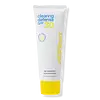What's inside
What's inside
 Key Ingredients
Key Ingredients

 Benefits
Benefits

 Concerns
Concerns

 Ingredients Side-by-side
Ingredients Side-by-side

Water
Skin ConditioningHomosalate
Skin ConditioningOctocrylene
UV AbsorberButylene Glycol
HumectantEthylhexyl Salicylate
UV AbsorberSilica
AbrasiveButyl Methoxydibenzoylmethane
UV AbsorberC12-15 Alkyl Benzoate
AntimicrobialButyloctyl Salicylate
Skin ConditioningVp/Eicosene Copolymer
Polyglyceryl-2 Distearate
EmulsifyingSaccharide Isomerate
HumectantTapioca Starch
Coriandrum Sativum Fruit Oil
MaskingCamellia Sinensis Leaf Extract
AntimicrobialSodium Ascorbyl Phosphate
AntioxidantSalix Alba Bark Extract
AstringentTerpineol
MaskingThymol
AntimicrobialCitrus Aurantium Dulcis Peel Oil
MaskingDipotassium Glycyrrhizate
HumectantTocopheryl Acetate
AntioxidantPotassium Cetyl Phosphate
EmulsifyingArachidyl Alcohol
EmollientGlyceryl Stearate
EmollientPEG-100 Stearate
Behenyl Alcohol
EmollientXanthan Gum
EmulsifyingAcrylates/C10-30 Alkyl Acrylate Crosspolymer
Emulsion StabilisingArachidyl Glucoside
EmulsifyingEthylhexylglycerin
Skin ConditioningTrisodium Ethylenediamine Disuccinate
Citric Acid
BufferingSodium Citrate
BufferingSodium Hydroxide
BufferingGlycerin
HumectantBisabolol
MaskingPentylene Glycol
Skin ConditioningPropanediol
SolventHydroxyacetophenone
AntioxidantCaprylyl Glycol
EmollientPotassium Sorbate
PreservativeSodium Benzoate
MaskingLinalool
PerfumingLimonene
PerfumingGeraniol
PerfumingCitronellol
PerfumingWater, Homosalate, Octocrylene, Butylene Glycol, Ethylhexyl Salicylate, Silica, Butyl Methoxydibenzoylmethane, C12-15 Alkyl Benzoate, Butyloctyl Salicylate, Vp/Eicosene Copolymer, Polyglyceryl-2 Distearate, Saccharide Isomerate, Tapioca Starch, Coriandrum Sativum Fruit Oil, Camellia Sinensis Leaf Extract, Sodium Ascorbyl Phosphate, Salix Alba Bark Extract, Terpineol, Thymol, Citrus Aurantium Dulcis Peel Oil, Dipotassium Glycyrrhizate, Tocopheryl Acetate, Potassium Cetyl Phosphate, Arachidyl Alcohol, Glyceryl Stearate, PEG-100 Stearate, Behenyl Alcohol, Xanthan Gum, Acrylates/C10-30 Alkyl Acrylate Crosspolymer, Arachidyl Glucoside, Ethylhexylglycerin, Trisodium Ethylenediamine Disuccinate, Citric Acid, Sodium Citrate, Sodium Hydroxide, Glycerin, Bisabolol, Pentylene Glycol, Propanediol, Hydroxyacetophenone, Caprylyl Glycol, Potassium Sorbate, Sodium Benzoate, Linalool, Limonene, Geraniol, Citronellol
Zinc Oxide
Cosmetic ColorantArgania Spinosa Kernel Oil
EmollientCentella Asiatica Extract
CleansingCetearyl Glucoside
EmulsifyingCetearyl Alcohol
EmollientCoco-Caprylate/Caprate
EmollientDisodium EDTA
Gluconolactone
Skin ConditioningGlycerin
HumectantCI 77499
Cosmetic ColorantCI 77491
Cosmetic ColorantCI 77492
Cosmetic ColorantIsostearic Acid
CleansingCaprylic/Capric Triglyceride
MaskingOctyldodecanol
EmollientPEG-30 Dipolyhydroxystearate
EmulsifyingPolyglyceryl-3 Polyricinoleate
EmulsifyingWater
Skin ConditioningSodium Benzoate
MaskingSodium Chloride
MaskingXanthan Gum
EmulsifyingZinc Oxide, Argania Spinosa Kernel Oil, Centella Asiatica Extract, Cetearyl Glucoside, Cetearyl Alcohol, Coco-Caprylate/Caprate, Disodium EDTA, Gluconolactone, Glycerin, CI 77499, CI 77491, CI 77492, Isostearic Acid, Caprylic/Capric Triglyceride, Octyldodecanol, PEG-30 Dipolyhydroxystearate, Polyglyceryl-3 Polyricinoleate, Water, Sodium Benzoate, Sodium Chloride, Xanthan Gum
Ingredients Explained
These ingredients are found in both products.
Ingredients higher up in an ingredient list are typically present in a larger amount.
Glycerin is already naturally found in your skin. It helps moisturize and protect your skin.
A study from 2016 found glycerin to be more effective as a humectant than AHAs and hyaluronic acid.
As a humectant, it helps the skin stay hydrated by pulling moisture to your skin. The low molecular weight of glycerin allows it to pull moisture into the deeper layers of your skin.
Hydrated skin improves your skin barrier; Your skin barrier helps protect against irritants and bacteria.
Glycerin has also been found to have antimicrobial and antiviral properties. Due to these properties, glycerin is often used in wound and burn treatments.
In cosmetics, glycerin is usually derived from plants such as soybean or palm. However, it can also be sourced from animals, such as tallow or animal fat.
This ingredient is organic, colorless, odorless, and non-toxic.
Glycerin is the name for this ingredient in American English. British English uses Glycerol/Glycerine.
Learn more about GlycerinSodium Benzoate is a preservative. It's used in both cosmetic and food products to inhibit the growth of mold and bacteria. It is typically produced synthetically.
Both the US FDA and EU Health Committee have approved the use of sodium benzoate. In the US, levels of 0.1% (of the total product) are allowed.
Sodium benzoate works as a preservative by inhibiting the growth of bacteria inside of cells. It prevents the cell from fermenting a type of sugar using an enzyme called phosphofructokinase.
It is the salt of benzoic acid. Foods containing sodium benzoate include soda, salad dressings, condiments, fruit juices, wines, and snack foods.
Studies for using ascorbic acid and sodium benzoate in cosmetics are lacking, especially in skincare routines with multiple steps.
We always recommend speaking with a professional, such as a dermatologist, if you have any concerns.
Learn more about Sodium BenzoateWater. It's the most common cosmetic ingredient of all. You'll usually see it at the top of ingredient lists, meaning that it makes up the largest part of the product.
So why is it so popular? Water most often acts as a solvent - this means that it helps dissolve other ingredients into the formulation.
You'll also recognize water as that liquid we all need to stay alive. If you see this, drink a glass of water. Stay hydrated!
Learn more about WaterXanthan gum is used as a stabilizer and thickener within cosmetic products. It helps give products a sticky, thick feeling - preventing them from being too runny.
On the technical side of things, xanthan gum is a polysaccharide - a combination consisting of multiple sugar molecules bonded together.
Xanthan gum is a pretty common and great ingredient. It is a natural, non-toxic, non-irritating ingredient that is also commonly used in food products.
Learn more about Xanthan Gum